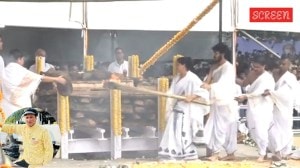At Leh, US forces take a samosa break
The humble samosa played its quiet role in boosting Indo-American strategic tie-ups today as the 19 United States Special Forces troops coop...

The humble samosa played its quiet role in boosting Indo-American strategic tie-ups today as the 19 United States Special Forces troops cooped up in a small Leh hotel acclimatising to the high-altitude, gearing up for “Exercise Balance Iroquois”.
Samosas with chutney were the favourite among the US soldiers as they drew up various exercise plans and modules for the exercise which will begin at 7 am on Monday morning.
At the 14 Corps headquarters, men from their elite Para (SF) and a sprinkling of personnel from the SF battalions were getting ready for the exercise which will mark a quantum jump in the Indo-US military relationship that started in May 2001.
According to military sources here, earlier exercises were planned to explore the ‘‘lift capability’’ of the two countries if they had to respond to an exigency in this part of the world. But this time the exercise is all about the nitty gritty — the essence of fighting shoulder-to-shoulder, conducting covert and counter-terrorist operations.
‘‘It’s all about getting our experience together. There are several areas where we excel and there are areas where they excel and we will be pooling it together for common ground and help promote inter-operability,’’ said a senior Indian Army officer.
The key word here is ‘‘inter-operability’’. Modelled on the British Army, India’s Special Forces, elite in their own right, is learning all about greater insertion depths, communications techniques and greater fire-power from the US personnel.
While Indian para-commandos have honed their skills on conducting cross-border raids during hostilities, from the Americans they hope to learn operating in small two-three-men teams behind enemy lines, or even conduct operations in training hostile elements in enemy countries to carry out sabotage strikes.
The fact that some of the US personnel who were directed to Leh by US Special Operations Command based at Fort Bragg, North Carolina, have served in Iraq and Afghanistan has not lost on the Indian military leadership.
Lessons learnt here will help take forward the proposed modernisation of the Indian Special Forces in the coming days.
The Americans have been drawn from various units of the Special Operations Command and are small teams brought together to help the Indians sample a multitude of skills that the US Special Forces — Rangers, Delta Detachments, Seals — have developed over the years.
It is learnt that other key Special Forces’ skills such as designating a target with lasers, helping Air Force bombers obliterate the enemy’s strategic assets, are part of the present package. It is timely as the Indian Special Forces are awaiting their own laser target designators as well as brand new Tavor Assault rifles (the first military to use them) from Israel soon. An area under the operational command of the Indian Army’s 3rd Division has been designated as the exercise area which has been cut off from prying eyes.
While final details are still being worked out, the first day will be dedicated to brian-storming between the teams from both countries. This will help facilitate better coordination and understanding in exercises which will see them pitted against each other at times, or working together conducting ‘‘secret operations’’, say sources.
However, with Sunday being devoted to more acclimatisation, with the aid of specially-procured medicines that help the intake of oxygen in this rarefied atmosphere, it was time for some sightseeing for the US personnel.
‘Sindhu Darshan’ — a must for all tourists visiting the age-old monastery in Thiksay — was part of the sight-seeing package developed by
the Indian parachute battalion which is serving host to the Americans.
The fact that this region is a few hours drive from Kargil has some team members interested. It is the nearest they can get to being part of India’s military history in recent times.
Photos



- 01
- 02
- 03
- 04
- 05




























